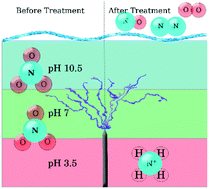Aqueous phase corona discharge for the reduction of nitrate in solution
Abstract
Aqueous phase corona discharge presents potential as an alternative technology that employs the generation of highly energetic radicals that reduce nitrate to gaseous compounds (denitrification). Water molecules are excited under the influence of a pulsed applied electric potential and are ionized into hydroxyl radicals and hydrogen radicals, which can react with other species present in secondary reactions to enhance reduction. The purpose of this study is to demonstrate the application of aqueous phase plasma to reduce nitrate in and aqueous solution by applying pulsed high voltage to submerged electrodes to initiate the breakdown of the water medium. Optimal water matrix characteristics for denitrification were determined by varying the solution pH, conductivity, temperature, and methanol (CH3OH) concentration (as an oxidative species scavenger). It was determined that the reduced nitrogen largely escapes solution through gaseous by-products. Nitrate was removed by this technique to some degree under all conditions investigated in this work; however, optimal performance was demonstrated under acidic conditions. Over 99% removal of an initial nitrate concentration of 0.03 mM was achieved at a pH of 3.5, solution electrical conductivity of 500 μS cm−1, temperature of 50 °C, and a methanol concentration of 3 M. The same water matrix characteristics with higher initial nitrate concentrations of 0.3 mM and 3 mM resulted in 82.2% and 26.1% removal, respectively.



 Please wait while we load your content...
Please wait while we load your content...